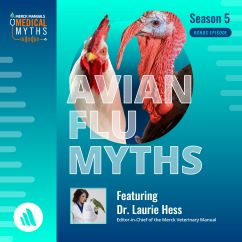The bird flu virus rarely spreads from animals to people (spread to people may occur if the genetic material of the virus mutates).
Nearly all people who have been infected with bird flu have had close contact with an infected bird (it almost never spreads from one person to another).
People may have extreme difficulty breathing and flu-like symptoms.
To diagnose bird flu, doctors test a sample of secretions from the person's nose or throat.
Bird flu is treated with antiviral medications.
(See also Influenza.)
Bird flu is caused by several strains of influenza A virus that normally infect wild birds. The infection can spread to domestic birds. However, it rarely spreads from animals to people. It may spread from birds to people if the genetic material of the virus changes (mutates), enabling the virus to attach to cells in the human respiratory tract. Nearly all people who have been infected with bird flu have had close contact with an infected bird. Bird flu almost never spreads from person to person.
Human infection with the avian influenza strain H5N1 (see influenza types and strains) first occurred in Hong Kong in 1997 and then spread to other nations. Two cases of H5N1 have been reported in humans in the United States. One case was in Colorado in 2022 likely due to contact with infected poultry. The second case was in a dairy farm worker in Texas in 2024. H5N1 was reported among dairy cattle in several states in 2024. The Centers for Disease Control and Prevention (CDC) and the United States Department of Agriculture (USDA) continue to monitor the situation (see CDC: Information on Bird Flu and H5N1 Bird Flu: Current Situation Summary; also see USDA: Highly Pathogenic Avian Influenza (HPAI) Detections in Livestock).
In 2013, an outbreak of the avian flu strain H7N9 began in southeastern China. Another wave of infection in humans in China peaked in 2016–2017 with nearly 800 cases, and only sporadic cases have been reported since that time. Worldwide, over 1500 human cases and at least 615 deaths have been reported to the World Health Organization since 2013. The infection has occurred mainly in communities that consume poultry from live poultry markets.
Other strains of the avian flu virus have also caused sporadic outbreaks of infection in people.
Symptoms of Bird Flu
H5N1 and H7N9, the strains of virus that cause most cases of bird flu in people, have similar effects.
People may have flu-like symptoms (such as fever, cough, sore throat, and muscle aches). Some people have conjunctivitis (inflammation in the conjunctiva, which is part of the eye). Some have difficulty breathing or pneumonia.
Diagnosis of Bird Flu
Testing of a sample taken from the nose or throat
People should contact a doctor to be tested for bird flu if they have flu-like symptoms plus one of the following:
They have had contact with birds in an area where birds are known to carry the infection.
They have had contact with a person infected with bird flu.
The doctor can send a sample taken by swabbing the nose or throat to be tested.
Treatment of Bird Flu
Antiviral medications
Infected people are given baloxavir, oseltamivir, or zanamivir (Infected people are given baloxavir, oseltamivir, or zanamivir (antiviral medications that are used to treat influenza). These medications usually improve survival (see CDC: Prevention and Antiviral Treatment of Bird Flu Viruses in People).
Prevention of Bird Flu
People should avoid contact with sick or dead animals, especially wild and domesticated birds, poultry, and cattle. Raw or undercooked food products, such as unpasteurized milk and dairy products, should also be avoided. The commercial milk supply in the United States is being tested, and no live, infectious virus has been found in pasteurized milk. Dairies are required to follow food safety practices, including sending only milk from healthy animals into processing for human consumption, and pasteurization is required for milk sold in stores.
China is vaccinating poultry with a vaccine to prevent H5 and H7 flu viruses. This vaccination program can help prevent the bird flu virus from spreading from wild birds to domestic birds. Domestic birds are more likely to come in contact with people and spread the virus to them.
Spread is contained by identifying and destroying infected flocks of domestic birds.
In the United States, a vaccine for people against H5N1 bird flu is available for distribution if deemed necessary by public health authorities. The standard vaccine for influenza does not prevent bird flu.
